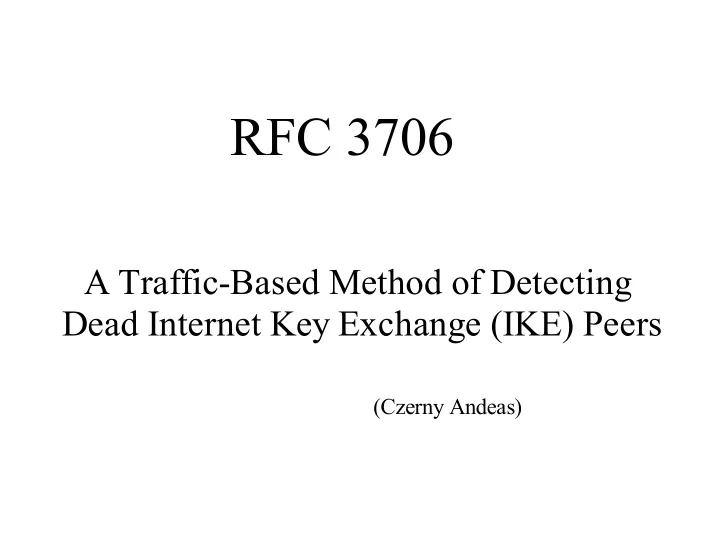

RFC 3706 A Traffic-Based Method of Detecting Dead Internet Key Exchange (IKE) Peers (Czerny Andeas)
Summery 1. Introduction 2. Keepalives and Heartbeats 3. DPD Protocol 4. Resistance to Replay Attack and False Proof of Liveliness
Situation Peer A Peer B Internet Protected IP traffic IKE IKE Problem if connectivity goes down ● No way for IKE and IPSec to identify the loss of peer connectivity ● The SAs can remain until their lifetimes naturally expire SA = Security Association
"Black Hole" Situation ● Packets are tunneled to oblivion ● It is often desirable to recognize black holes as soon as possible - failover to a different peer quickly. - recover lost resources. ● Proposals - sending periodic HELLO/ACK messages to prove liveliness.
Keepalives and Heartbeats ● Bidirectional "keepalive" message exchange - a HELLO followed by an ACK only on side is interested in liveliness ● Unidirectional "heartbeat" message exchange - a HELLO only both sides have to demonstrate liveliness
Scenario 1 Peer A Peer B A's 10 sec. timer elapses first HELLO Sends HELLO to B Receives HELLO Acknowledges A's liveliness Resets keepalive timer ACK Sends ACK Receives ACK as proof of B's liveliness Reset keepalive timer
Scenario 2 Peer A Peer B (dead) A's 10 sec. timer elapses first HELLO Sends HELLO to B (dead) Retransmission timer expires Message could have lost in transit A increments error counter Sends another HELLO (dead) ....
Scenario 3 Peer A Peer B A's 10 sec. timer elapses first HELLO Sends HELLO to B Receives HELLO as proof of A's liveiness B's 10 sec. timer elapses HELLO Receives HELLO as Sends HELLO proof of B's liveliness
Scenario 4 Peer A Peer B A's 10 sec. timer elapses first HELLO Sends HELLO to B (dead) .... Assumes B is dead
DPD Protocol ● A peer is free to request proof of liveliness when it needs it. ● asynchronous property allows fewer messages to be sent ● IPSec traffic itself serves as the proof of liveliness. ● Knowledge of the peer's liveliness, is only necessary if there is traffic to be sent.
DPD implementation ● In DPD, each peer can define its own "worry metric". ● the decision about when to initiate a DPD exchange is implementation specific. ● Each peer's DPD state is largely independent of the other's.
DPD Vendor ID ● Both peers of an IKE session MUST send the DPD vendor ID before DPD exchanges can begin 0 1 2 3 4 5 6 7 8 9 0 1 2 3 4 5 +-+-+-+-+-+-+-+-+-+-+-+-+-+-+-+-+ MM HASHED_VENDOR_ID J N HASHED_VENDOR_ID R R +-+-+-+-+-+-+-+-+-+-+-+-+-+-+-+-+ ● MJR and MNR correspond to the current major and minor version of this protocol
Message Exchanges Peer A Peer B NOTIFY(R-U-THERE) NOTIFY(R-U-THERE-ACK) ● The DPD exchange is a bidirectional message. ● Both messages are simply ISAKMP Notify payloads ( Internet Security Association and Key Management Protocol) Notify Message Value R-U-THERE 36136 R-U-THERE-ACK 36137
● A peer MUST keep track of the state of a given DPD exchange. ● Retransmit R-U-THERE queries when it fails to receive an ACK. ● After some number of retransmitted messages delete IPSec and IKE SAs to the peer.
Message Format +-+-+-+-+-+-+-+-+-+-+-+-+-+-+-+-+-+-+-+-+-+-+-+-+-+-+-+-+-+-+-+-+ Next Payload RESERVED Payload Length Next Payload RESERVED Payload Length ----------------------------------------------------------------------------------------- Domain of Interpretation (DOI) Domain of Interpretation (DOI) ----------------------------------------------------------------------------------------- Protocol-ID SPI Size Notify Message Type Protocol-ID SPI Size Notify Message Type ----------------------------------------------------------------------------------------- ~ Security Parameter Index (SPI) ~ Security Parameter Index (SPI) ~ -+-+-+-+-+-+-+-+-+-+-+-+-+-+-+-+-+-+-+-+-+-+-+-+-+-+-+-+-+-+-+- ----------------------------------------------------------------------------------------- Notification Data ! Notification Data +-+-+-+-+-+-+-+-+-+-+-+-+-+-+-+-+-+-+-+-+-+-+-+-+-+-+-+-+-+-+-+-+ ● Notify Message Type (2 octets) - MUST be set to R-U-THERE ● Security Parameter Index (16 octets) - SHOULD be set to the cookies of the Initiator and Responder of the IKE SA ● Notification Data (4 octets) - MUST be set to the sequence number corresponding to this message
Implementation Suggestion ● Liveliness of a peer is only questionable when no traffic is exchanged ● A viable implementation might begin by monitoring idleness. ● A peer's liveliness is only important when there is outbound traffic to be sent. ● initiate a DPD exchange if outbound IPSec traffic was sent, but not received any inbound IPSec packets. ● A complete DPD exchange will serve as proof of liveliness until the next idle period.
Comparisons DPD vs keepalive/heartbeats ● Performance benefit: DPD do not need to sent regular messages. The number of IKE messages to be sent and processed is reduced. ● Implementation benefit: DPD needs only 1 timer
Resistance to Replay Attack and False Proof of Liveliness Sequence Number in DPD Messages ● A responder to an R-U-THERE message MUST send an R-U-THERE-ACK with the same sequence number. ● The initial sender SHOULD reject the R-U-THERE-ACK if the sequence number fails to match the one sent with the R-U-THERE message. ● both SHOULD check the validity of the Initiator and Responder cookies presented in the SPI field of the payload.
Selection and Maintenance of Sequence Numbers ● both DPD peers can initiate a DPD exchange ● each peer MUST maintain its own sequence number ● The first R-U-THERE message sent in a session MUST be a randomly chosen number ● the high-bit of the sequence number initially SHOULD be set to zero. ● Sequence numbers MAY reset at the expiry of the IKE SA ● Maintain a window of acceptable sequence numbers
Benefit of sequence numbers ● detecting replayed messages prevents from needing to build, encrypt, and send ACKs. ● sequence numbers is that it adds an extra assurance of the peer's liveliness.
Recommend
More recommend